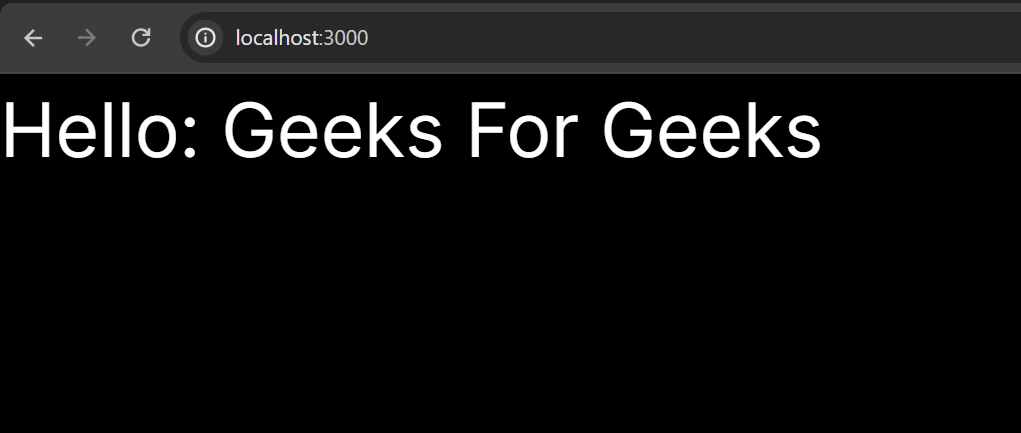
|
|
Next.js API Routes are a feature of Next.js that allows you to create server-side logic and APIs within your Next.js application. These API routes are implemented using files in the `pages/api` directory of your Next.js project. When you deploy your Next.js application, these API routes are automatically served as serverless functions. Table of Content ApproachTo use Next.js API routes, create a file in the Key points about Next.js API Routes
Here’s an ;example of a simple API route in Next.js: In this example, visiting `/api/hello` in your Next.js application will trigger this API route, and it will respond with a JSON object containing the message “Hello from the API!”. Dynamic API RoutesDynamic API routes in Next.js allow you to create flexible endpoints that handle dynamic parameters in the URL. This is useful for building APIs that require variable data, such as fetching specific resources based on IDs or filtering data based on query parameters. Here’s how you can create dynamic API routes in Next.js:
Here’s an example of a dynamic API route in Next.js that handles a user ID parameter: In this example, visiting `/api/users/123` in your Next.js application will trigger this API route, and it will respond with a JSON object containing the user data for ID 123. Steps to Create and Use API Routes in Next.jsStep 1: Creating an API Route
In this example, visiting `/api/users/123` in your Next.js application will trigger this API route, and it will respond with a JSON object containing the user data for ID 123. Step 2: API Routes Configuration2.1 Custom Route Paths:By default, API routes in Next.js follow a file-based routing convention (`pages/api/`). However, you can customize the route paths using the `basePath` option in your `next.config.js` file. For example: With this configuration, your API routes will be accessible under the `/api` path, such as `/api/users` instead of `/api/users.js`. 2.2 API Route Middleware:You can add middleware functions to your API routes to handle common tasks like authentication, request validation, error handling, etc. Middleware can be applied globally or selectively to specific API routes. Here’s an example of adding middleware using the `next-connect` package: 2.3 Environment Variables:You can use environment variables to configure your API routes dynamically based on different environments (development, production, testing, etc.). Next.js provides built-in support for environment variables using `.env` files. For example: # .env.local
API_KEY=your_api_keyThen, access the environment variable in your API route like this: 2.4 API Route Caching:You can implement caching strategies in your API routes to improve performance and reduce server load. Use caching libraries like `node-cache` or `redis` to store and retrieve cached data within your API logic. 2.5 Error Handling:Implement robust error handling mechanisms in your API routes to gracefully handle errors, log them for debugging, and send appropriate error responses to clients. You can use try-catch blocks, error middleware, or custom error classes for this purpose. 2.6 Request Validation:Validate incoming requests to your API routes to ensure they meet the required format, data types, and constraints. Use validation libraries like `joi`, `express-validator`, or write custom validation logic as per your application’s needs. Step 3: Typing API Routes with TypeScriptWhen typing API Routes with TypeScript in Next.js, you can ensure type safety by defining types for request and response objects as well as for response data. Here’s how you can do it: 3.1 Typing Request and Response Objects:In your API route files (`pages/api/…`), import the appropriate types from `next` to type the request and response objects. For example, to type a GET request and response: // pages/api/users.ts [typescript] In this example, `NextApiRequest` and `NextApiResponse<Data>` are imported from `next` and used to type the request and response objects, respectively. The `Data` type represents the structure of the response data. 3.2 Typing Response Data:Define types for the data you expect to send in the response. This can be done using TypeScript interfaces or types. For example, defining an interface for user data: // types/User.ts [typescript] Then, use this interface in your API route to type the response data: // pages/api/users.ts [typescript] Here, `User` is imported from the `User.ts` file in the `types` directory to type the response data. Step 4: Accessing an API RouteYou can access an API route from your frontend code (React components) using techniques like fetch or libraries like Axios. Here’s an example using fetch: Output:  Output ConclusionIn this article, we’ve looked at setting up an API route in Next.js. Next.js simplifies the process of implementing an API for your applications. It offers a couple of advantages: it does not require configuration, isolates every handler as a standalone function, has great middleware support, etc. |
Reffered: https://www.geeksforgeeks.org
| ReactJS |
Type: | Geek |
Category: | Coding |
Sub Category: | Tutorial |
Uploaded by: | Admin |
Views: | 16 |